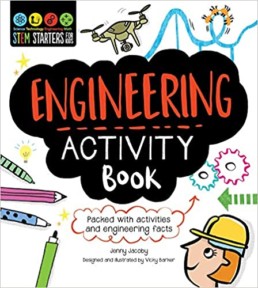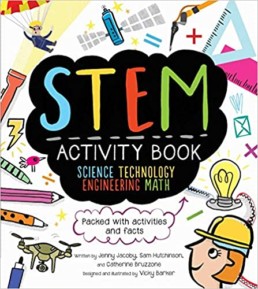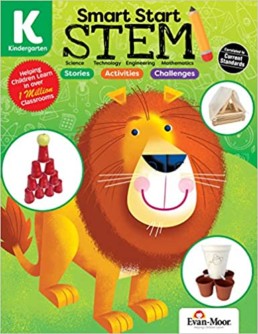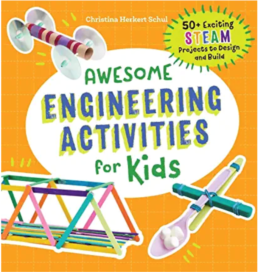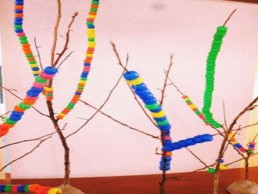How to Make Structures with Pasta
What can we build with pasta? Inspire your little engineers with this fun activity! You can use any type of pasta but provide as much variety (parts) as you can. No need to use glue either! You can just use playdough to bind the pieces together!
What you will need
- Pasta of as many kinds as you can find. You can also use homemade coloured pasta
- Playdough
Let’s get started!
- Set up the play area in an easily wipeable area, such as a table
- Place the various kinds of pasta in containers so children have it sorted by kind and/or colour
- Display the various colours of playdough (note: you can have just one kind since it is just to bind the pieces together, it’s up to you)
- Ask an open-ended question, such as: “I wonder if we could build a structure using pasta?”
- Make sure you let children try different ways of building, don’t “teach” them how to build – the important learning element here is to problem-solve, to try, fail, try again, get closer, keep trying!
Learning opportunities
Children will learn STEM while building their structures, which will work on their problem-solving and engineering skills. To make the most out of this process, ask what questions (instead of why questions):
- What happened there?
- What did you try?
- What did you change?
- What did you do differently this time?
- What are your ideas about what to try next?
- What do you think will happen if we _________ ?
CEFA tip: Remember to let your child do as much of the process as they are capable of.
Related books you might like
In order to truly understand these concepts, it is always best for your children to have as many hands-on activities and manipulatives as possible. An activity that they can touch, feel and play with is so much better than a worksheet or book. If your child really has a passion for this subject, or if you need an activity that is educational but does not require as much supervision, then books and workbooks can be fun! Plus, it really depends on your child. Some children love reading and working on workbooks (I was one of them) and can find them entertaining for hours on end, while others prefer real play experiences. Whatever your child’s preference may be, make sure you always provide manipulatives (rather than only workbooks or activities on paper). Trust me on this one.
Does early education really promise a brighter future?
Most parents who send their children to an early learning program are very happy with their decision. Some say it is a great way for children to meet friends, some find it an essential step for them to learn to socialize. Some even notice that their children learn a great deal! But few of these parents believe deep down that thanks to those early learning years, their children will be, well, smarter.
How can that be? After all, the academic knowledge given to the child during those years is not so unique compared to elementary school. Does it really matter if a child can read at age three instead of six? Is it really that important to know all the numbers before kindergarten? Why not just let them play and enjoy life?
Firstly, the secret is not in the academic component itself. Children who attend early education programs are better equipped to learn because they have received the right type and the right amount of stimulation at the right time in their lives.
Secondly, what most of us don’t realize is that for children, learning is enjoyable, if it is presented appropriately. Children are constantly learning. Take newborn babies, for instance. When they are not sleeping, they are constantly learning. They learn to recognize our voices, their environment, the patterns of their mobiles and the many things we are excited to bring closer to them. One and two-year old’s are discovering language, and figuring out their role in the household. They even have their own scientific agenda, which they carry out quite well by experimenting on everything they can find. They are constantly asking us questions! The world is a fascinating place for a young child. Once they gain a greater understanding of their environment, they need a higher level of reasoning and intellectual stimulation.
From birth until about age six, a child’s brain is forming all the pathways it will use during adult life. This process considerably slows down after that age. Those pathways can only be formed through adequate stimulation, which explains why young children are constantly looking to learn. This means that what the child learns early on in life, will determine how much he or she can learn as an adult. You can compare this process to the child’s physical growth. A one year old is so much more developed than a one day old, but it is harder to see the difference between a seven year old and an eight year old. As parents, we pay special importance to what our children eat, because we know that it will impact them for life. If they do not grow at that age, they will certainly not start growing in their thirties (at least most of us have given up hope by then). Similarly, what you “feed” your child’s brain during the first years of life determines how easily your child will be able to learn, for life. Since school in Canada officially starts at age five, early education is not only a good idea: it is essential for the proper development of a your child.
A good program is very enjoyable for children. It enables them to keep pursuing their interests at a much more stimulating level. Of course, not any program will do. A good pre-school or junior kindergarten school will stimulate your child at just the right level, and in many ways. Simply providing a nice atmosphere to socialize and a craft project for the day is great fun, but it is not the level of stimulation that your child needs in order to develop adequately. Instead, look for a program that offers activities that take into consideration each child’s interests and level of understanding, and is varied in nature. Music and arts are just as important at that age, as reading, or science.
This does not mean that your two-year-old will be sitting at a desk, pen and paper in hand. Good programs are very creative in their approach to learning, and present children with projects. Concepts are taught through games and fun activities where your child is always an active participant. Look for a program that can present a challenge as well as a fun, magical environment.
Early education is an essential step in your child’s life, and one every parent should welcome. You may never be able to measure how much it impacted your child, but you can trust that it did.
Published 2004/10/07 in BC Parents Magazine
Published 2011/12/28 VancouverMom.ca
Published 2012/03/19 in Urban Baby and Toddler Magazine
Why only some children learn from their mistakes
An excited three-year-old grabs a bottle of milk from the table and joyfully shakes it until its contents spill all over the kitchen floor. The child’s mother rushes towards the pool of white liquid spreading across the tiles, looks up at her child and grins. “What happens now?” she asks enthusiastically. They explore the consequences together. No scolding or words of disapproval are muttered. Sound unlikely? In most North American households this scenario would play out very differently. That’s because too often parents are quick to scorn their children for making mistakes. In reality, however, there are great advantages to teaching your children to learn from their mistakes.
A new study from Michigan State University, shows people who think they can learn from their mistakes have a different brain reaction to errors than those who don’t.
The study demonstrates that people who think they can learn from their mistakes bounce back faster after making one. Furthermore, their brains are more alert to the fact they’ve made a mistake, and subsequently are quicker to correct it. This way of thinking is a pattern that can be developed in childhood.
Children who expect to make mistakes are much more willing to try new things and take on difficult tasks. As a result, they’re open to learning more both at school and in other environments.
Parents who feel aversion to making mistakes themselves often pass this burden on to their children. However, once aware, there is a great opportunity to break the cycle. Parents can assure their children’s mistake are normal, in fact even grown-ups make them. What matters is what we do to correct them.
How To Turn Mistakes Into Learning Opportunities
The first step is to acknowledge when your child has made a mistake and explore the outcome. Ask what they learned from the experience, and how they think they can improve the next time around. Reiterate as often as you can that making mistakes means learning something new.
Consistency is key. When you are the one making a mistake, make sure you react the same way. For example, if you break a glass you can say, “I made the mistake of leaving it too close to the edge of the table. Next time, I’ll be careful to leave it in the center instead, so it won’t fall when I move my arms.”
If your it is your child who breaks a glass, respond calmly. Telling your child something along the lines of “I told you so” does not help. Instead, ask questions like, “how did your glass fall?” or “what can you do next time, so you don’t make that same mistake?” This allows your child to determine where they went wrong and think of a solution for next time.
The second step is to instill the habit of taking responsibility for one’s mistakes. Many parents rush to fix their children’s mistakes. In doing so they rob their children of the opportunity to shoulder responsibility. Going back to the broken glass scenario. Once your child has determined why the glass broke and how they can prevent it from falling next time, ask how they plan to fix the problem, and let them clean the mess without assistance. Figuring out how to solve the problem provides an opportunity for your child to learn responsibility and gain confidence in knowing mistakes can be made right, or at least better. Children can gain much pride from knowing they can be trusted to find an adequate solution to a problem they themselves create.
When children learn from their mistakes and are encouraged to find creative solutions, they develop problem-solving skills that last long into the future.
Originally published in:
L.A. Parent (December 29 2011)
Urban Baby and Toddler Fall 2013
Beaded Branches
As children grow and their fine motor skills develop, parents should use increasingly difficult exercises to keep up with their child’s level of learning. This particular activity is not for babies and young toddlers because of the beads being so small, it can be frustrating for them as well as a choking hazard. You can, however, easily modify this activity and use larger “beads” like paper towel rolls cut into rings, or colored pasta if they find the large rings too easy (rigatoni would be good).
This is an activity that is free to make (depending on the materials you use). Plus, you get to go on a walk around your neighbourhood to find small branches for the project.
What you need
- One or two small branches
- Plasticine, clay, a cup, or anything you can find to stick the branch in to keep it upright
- Beads
Let’s get started!
- Find a nice cozy space (perhaps in front of a window) and a work surface
- Place your branches on your work surface and a cup with beads.
CEFA tip: if the area is carpeted, it will be a lot easier to pick up the beads that fall 🙂 - You can work on a branch alongside your child, or just let them enjoy the activity on their own.
Learning opportunities
Children will practice fine motor and hand-eye coordination, both essential for writing. It is also a way for children to develop their artistic talent and express themselves in their own unique way.

